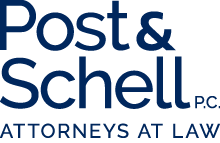

DEP Issues New Stormwater General Permit Requirements for Industrial Activity

The Pennsylvania Department of Environmental Protection (DEP) has reissued the National Pollutant Discharge Elimination System (NPDES) General Permit for Discharges of Stormwater Associated with Industrial Activity (PAG-03).1 The reissued PAG-03 contains significant new and expanded responsibilities for permit holders, including best management practices (BMPs) and stormwater sampling obligations that were not required under the previous version of PAG-03. Additional changes to the reissued PAG-03 involve eligibility for a General Permit; self-monitoring, reporting and recordkeeping; and site inspections.
Obtaining New Permit Coverage or Maintaining Existing Permit Coverage
Existing general permit holders are automatically covered under the reissued PAG-03 as of September 24, 2016, subject to the terms and conditions of the reissued permit. Existing permit holders are not required to complete a Notice of Intent (NOI) to continue discharging under the reissued permit unless they are seeking new or amended coverage.2
Facilities without an existing permit can apply for coverage under the new PAG-03 by submitting a NOI to DEP at least 60 days prior to the planned date for commencing any stormwater discharge. After coverage under the reissued PAG-03 is approved, coverage will continue each year. Once DEP has granted a facility approval to operate under PAG-03, unless specified by DEP, a NOI is not required to renew permit coverage as long as the permit holder implements the required BMPs and maintains compliance with the General Permit.
In light of the expanded scope of the new PAG-03, it also may be possible for some facilities that currently have individual NPDES permits for stormwater discharges to convert to coverage under the new PAG-03. If facilities find the new general permit terms to be beneficial, and the facility can meet the required conditions, it may be prudent to consider a conversion.
Timeline for Compliance with New Permit Requirements
The deadline for implementing new BMPs3 is September 24, 2017. While DEP indicated in its Fact Sheet on PAG-034 and the Pennsylvania Bulletin notice5 that it is allowing permit holders a “transition period” of up to one year to comply with new BMPs, it is unclear whether that grace period applies to all the new requirements. The definition of a BMP appears broad enough to encompass nearly all of the new requirements contained in PAG-03; however, DEP has specifically identified a list of BMPs applicable to all permittees in the reissued version of the General Permit. Because several new requirements, including the obligation to conduct stormwater sampling, are not specifically identified on the list of BMPs in the reissued permit, permittees may not be able to rely on the one year transition period to begin complying with these requirements. Further guidance from DEP on whether it intends to provide the one year transition for all new requirements, whether or not they are specifically listed as a BMP would be helpful, as it begins to consider NOIs under the reissued permit in the coming months.
Assuming the new stormwater sampling requirements are effective immediately, all permittees covered by PAG-03 must conduct sampling beginning in the first semiannual period of 2017.
Best Management Practices
The reissued General Permit identifies several new BMPs to reduce pollutants in the stormwater discharges of industrial facilities. PAG-03 contains general BMPs applicable to all facilities as well as sector-specific BMPs. PAG-03 has been expanded to include 30 specific industrial sectors from the 12 sectors that were included in the prior version. DEP included a provision in the revised permit that allows industrial operators flexibility in adopting sector-specific BMPs. Industrial facilities will be permitted to implement alternatives to the sector-specific BMPs in appropriate circumstances if prior authorization is obtained from DEP. Among the new BMPs are requirements that all facilitates use spill/overflow protection equipment, control discharges through secondary containment or treatment for open dumpsters and roll off boxes, install velocity dissipation devices at discharge sites, and maintain readily accessible spill kits in locations where spills may occur.
Eligibility Criteria
The reissued PAG-03 contains two additional eligibility criteria for obtaining a General Permit. If a wasteload allocation (WLA)6 has been assigned to a stormwater discharge in a Total Maximum Daily Load (TMDL)7 or if a facility withdraws at least 2 million gallons of water per day where 25% or more is used for cooling purposes,8 the discharge is not covered under the General Permit. These facilities must obtain a NPDES individual permit for their stormwater discharges.
Self-Monitoring and Reporting
The reissued General Permit contains substantial changes involving stormwater monitoring. Chief among these changes is the establishment of “benchmark values” for certain pollutants. A corrective action plan (CAP) must be submitted within 90 days following the end of a monitoring period when exceedances of the benchmark values have occurred in two or more consecutive monitoring periods for the same pollutant at the same outfall. A CAP is an informal document prepared by the permittee that explains what measures will be adopted to minimize stormwater pollutants. The CAP must be implemented immediately upon submission to DEP. As an alternative to suggesting remedial measures, a CAP may demonstrate that exceedances of the benchmark are unavoidable due to natural background sources and unavailability of additional feasible pollutant reduction measures. Although DEP has clarified that exceedances of the benchmark values are not violations, failure to submit a CAP to remediate or explain an exceedance would constitute a violation.
Monitoring must occur semiannually for key pollutants. Monitoring must be performed at all identified “representative outfalls.”9 However, monitoring of pollutants is not required at outfalls identified as “no exposure outfalls” in the NOI.10 DEP may require permittees to make an on-site location accessible for collecting stormwater samples. Permittees must collect stormwater samples when there is no commingling of non-stormwater discharges and preferably within the first 30 minutes of discharge.
Compliance monitoring results must be submitted electronically using DEP’s Discharge Monitoring Report (DMR) system. Existing permittees have until December 21, 2016 to register for the electronic DMR system with DEP’s Bureau of Clean Water. DMRs are due on January 28 and July 28 of each year, 28 days after each semiannual period. By May 1 of each year, permittees must submit an Annual Report addressing activities under the General Permit along with a $500 “Annual NOI Installment Fee.”
Facility Planning
Facilities that currently have coverage under the old PAG-03 should carefully evaluate the new requirements. While a year may seem like a long time to come into compliance, meeting some of the new requirements may involve time-consuming physical changes to the facility. Facilities that currently have individual NPDES permits for stormwater discharges may want to determine whether they are eligible to convert to the PAG-03 and whether there are advantages to doing so.
Footnotes:
1 In accordance with the Clean Water Act, 33 U.S.C. § 1251 et seq., and Pennsylvania’s Clean Streams Law, 35 P.S. § 691.1 et seq., all industrial operators must obtain a NPDES General Permit before discharging stormwater. DEP reissued a new General Permit on September 24, 2016 to replace the prior version of the permit issued on December 5, 2010. See 46 Pa.B. 6083. The changes to the General Permit were adopted to be consistent with the United States Environmental Protection Agency’s Multi-Sector General Permit for Stormwater Discharges Associated with Industrial Activity which was reissued in 2015.
2 The NOI form must be completed by any industrial operator seeking to discharge stormwater as a prerequisite to obtaining a NPDES General Permit.
3 BMPs are defined in 25 Pa. Code § 92a.2 as “[s]chedules of activities, prohibitions of practices, maintenance procedures and other management practices to prevent or reduce pollutant loading to surface waters of this Commonwealth” including “treatment requirements, operating procedures and practices to control plant site runoff, spillage or leaks, sludge or waste disposal, or drainage from raw material storage” and “activities, facilities, measures, planning or procedures used to minimize accelerated erosion and sedimentation and manage stormwater to protect, maintain, reclaim, and restore the quality of waters and the existing and designated uses of waters within this Commonwealth before, during and after earth disturbance activities.”
4 DEP PAG-03 Fact Sheet, http://www.elibrary.dep.state.pa.us, 3850-PM-BCW0083i, p. 8 (September 2016).
5 46 Pa.B. 6083 (September 24, 2016).
6 WLA means the portion of a surface water’s loading capacity that is allocated to existing and future point source discharges. 25 Pa. Code § 96.1.
7 TMDL means the sum of individual waste load allocations for point sources, load allocations for nonpoint sources and natural quality and a margin of safety expressed in terms of mass per time, toxicity or other appropriate measures. 25 Pa. Code § 96.1.
8 See 40 CFR §§ 125.81 and 125.91.
9 A “representative outfall” is defined in PAG-03 as “a point source selected by the permittee or DEP to represent the quality of stormwater for pollutant monitoring purposes because its drainage area characteristics are substantially identical in nature to the drainage area(s) of other point source(s) at the facility or site.”
10 “No exposure” occurs “where industrial materials and activities are protected by a storm-resistant shelter to prevent exposure to stormwater.” See 25 Pa. Code § 92a.2; 40 CFR § 122.26(g).
Disclaimer: This post does not offer specific legal advice, nor does it create an attorney-client relationship. You should not reach any legal conclusions based on the information contained in this post without first seeking the advice of counsel.

